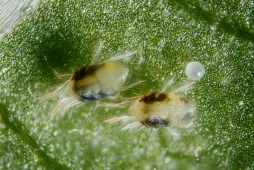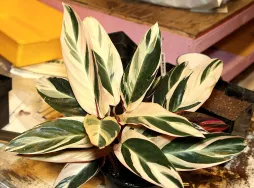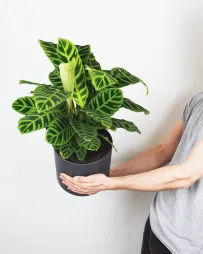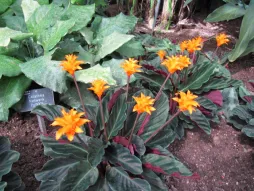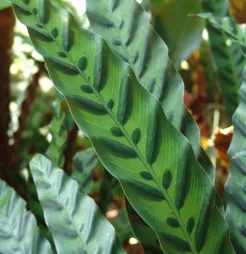Stromanthe thalia, the dancing plant
Stromanthe sanguinea, Stromanthe thalia by its Latin name, is native to Brazil. In the evening, this plant of the Marantaceae family erects its leaves, exposing their crimson undersides.
How to recognize Stromanthe sanguinea?
Stromanthe sanguinea is an upright perennial. It grows up to 1.80 meters tall in the wild. In our latitudes, it is grown in pots and indoors. It rarely exceeds 80 centimetres in all directions.
Stems grow vertically from a rhizomatous root. They may bear one or two leaves. They are short and extended by a long, sheathing petiole. At the end of the petiole is the pulvinus, a bulge found in plants of the Marantaceae family. It enables them to fold up their foliage when night falls and unfold it again when the sun rises.
The lanceolate leaf blades measure up to 45 centimetres long and ten centimetres wide. Their color varies according to hybrid and cultivar. In the botanical Stromanthe thalia, the upper surface is olive-green, sometimes veined with cream, while the underside is purple. The Stromanthe sanguinea 'Triostar variety has tricolored leaves: green, cream and pink.
Stromanthe thalia blooms in spring. Panicles of white flowers rise from a red bract.
The flowers, like the rest of the plant, are non-toxic. You can handle your Stromanthe sanguinea without risk of irritation. And your pets are in no danger if they ingest the leaves.
Our maintenance tips
Not very demanding, your Stromanthe thalia is content with a location without direct sunlight and plenty of humidity.
Watering
Your Stromanthe sanguinea likes its soil to be moist. But it hates excess water. Water when the surface of the substrate is dry (about a centimetre).
Use room-temperature, non-calcareous water, such as rainwater.
Drain any water that collects in the saucer or planter. It may rot the roots.
Spray
Mist the foliage with non-calcareous water at room temperature. This will increase humidity and limit pest attacks.
Repotting
In spring, transfer your Stromanthe thalia to a larger pot, so that it can continue to grow.
Choose a pierced pot one-third larger than the previous one. Choose width rather than height to allow roots to develop. Choose a plastic or ceramic container rather than a clay one. The latter tend to absorb water more quickly.
Install a bed of clay balls and cover it with potting soil for indoor plants. Don't hesitate to mix in some perlite to optimize drainage. Then place the rootball and add potting soil until you reach a centimetre or two below the rim of the pot. Tamp down to avoid air bubbles.
Fertilization
You can stimulate the development of your plant during its growth phase, in spring and summer, with fertilizer.
Apply a liquid fertilizer for green plants to stimulate growth.
Cleaning
Photosynthesis is slowed down by dust accumulating on the leaves. To help your Stromanthe sanguinea make the most of its exposure, clean the foliage with a clean, damp cloth.
Dusting also helps prevent pest attacks.
Prune
Using clean, sharp pruning shears, remove damaged or dried-out foliage.
Cutting
Cutting is carried out during the strong growth phase, generally in spring and early summer.
Rhizomes are underground stems. To access them, you'll need to dig up your plant. Proceed delicately so as not to damage the roots.
Observe the root system to detect the natural demarcation between rhizomes. Once you've identified two distinct roots, gently separate them using your hands.
In a pierced pot, pour a layer of clay balls for drainage. Add potting soil for seedlings and planting.
Using a pencil, make a pilot hole and plant your cutting.
Water at room temperature to help the plant take root.
Diseases / Threats
Information
| Family | Marantaceae - Marantaceae |
| Type | Stromanthe - Stromanthe |
| Species | Stromanthe sanguinea - Stromanthe thalia |
| Lifecycle | Perennial |
| Foliage | Evergreen |
| Exposures | |
| Substrat | |
| Planting method |
In pots |
| Categories | |
| Tags |
Flowery Fritillary |
| Origin |
South America |
| Hardiness (USDA) | 11b |
| Leaf color |
|
| Flower colors |
|
Discover plants from the same family













